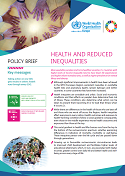SDG 10: Health and reduced inequalities

Download
More equitable societies tend to be healthier societies. Countries with higher levels of income inequality tend to have lower life expectancies and higher infant mortality rates, as well as higher prevalence for mental illness and obesity.
Key messages
- Although significant improvements in health have been achieved in the WHO European Region, persistent inequities in avoidable health risks and premature deaths remain between and within countries. In some countries they have even increased.
- Health inequities are avoidable and unfair. Social and economic conditions and their effects on people’s lives determine their risk of illness. These conditions also determine what action can be taken to prevent them becoming ill or to treat their illness when it occurs.
- While there are differences in the health of those who are best off and those who are worst off across the Region, health inequities affect everyone in every nation. Health outcomes and exposure to health-harming conditions follow a social gradient; consequently, even those in the middle experience worse health outcomes and exposures than those at the top.
- This social gradient in health and life chances runs from the top to the bottom of the socioeconomic spectrum, whether examining differences in indicators of mortality, morbidity or well-being. These inequities persist over the life cycle and are passed down through generations.
- Growing up in favourable socioeconomic circumstances leads to improved child development and facilitates higher levels of educational attainment, which, in turn, are associated with higher incomes, greater control over daily life and better health and wellbeing across every stage of life.
- Reducing inequalities in income, wealth, education, health-care services and access to power can contribute to the achievement of health and well-being goals for all. Within a relatively short period of time (2–6 years), differences can be narrowed.
- Reducing inequalities requires effective investments in multisectoral policies addressing social, economic, environmental and commercial determinants: the key factors which impact on the circumstances in which people are born, grow, live, work and age.



